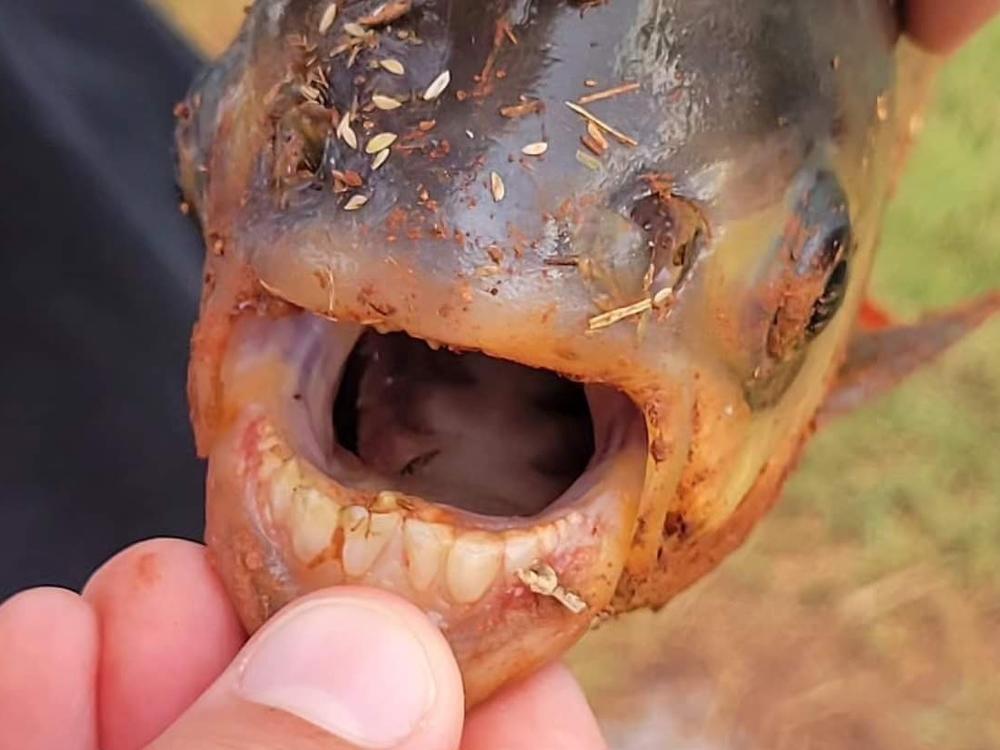Section Branding
Header Content
An 11-year-old boy caught a fish with 'human-like teeth' in an Oklahoma pond
Primary Content
Janna Clinton was sitting on her back porch watching her son Charlie, 11, fish in a pond behind their house in Oklahoma this past weekend when he suddenly started yelling for her.
"He was screaming, 'Oh my God, mom! Oh my God!' " Clinton told NPR.
"I thought he was just being dramatic, to be honest," she added.
Then she got a close look at Charlie's alarmingly weird catch.
"Obviously being in a neighborhood pond, we're used to just catching a few bass or catfish," she said. "I mean, nothing with human-like teeth."
It turned out that Charlie had landed a pacu, a fish that's a cousin of the piranha — and whose outsized teeth have long struck fear in swimmers. The pacu is a native of South America, but this one was swimming in a small pond in the Clintons' suburb north of Oklahoma City.
"He said it put up a heck of a fight," Janna told NPR, saying her son reeled the fish in on his own. "He was the only one down there fishing and he did a great job."
The pacu was released back into the water
The Clintons posted a photo of the unusual fish to their neighborhood Facebook page and got in touch with a game warden. But before learning of its provenance, they returned the pacu to the water.
"It's a catch and release pond," Janna said, "so we unfortunately did release it back because we didn't know any better at the time."
People who later recognized the fish said it was invasive and shouldn't be released, she said, adding, "We made a mistake there."
Since then, Charlie has been stalking the fish.
"He did stay at the ponds pretty late that night trying to catch it again," Janna said, adding that her son has been rising early and staying at the pond late, hoping to get another bite from that pacu.
If Charlie succeeds, a neighbor has offered to eat the pacu. But Janna Clinton has other ideas.
"If he catches it again, we're going to get it mounted for him. I think that's a heck of a prize and he deserves it," she said. "I told him we'd make it look like the fish was smiling so you could see its teeth."
The wildlife agency blames a pet owner for the pacu's presence
Game wardens believe the pacu was a pet that outgrew its tank and was released into the wild.
"How dare you," the Oklahoma Department of Wildlife Conservation said, addressing the fish's previous owner via Twitter and setting off a lively exchange with surprised members of the public.
"WHY DOES IT HAVE HUMAN TEETH," a dismayed commenter asked. "IDK WE DIDN'T MAKE THEM," the wildlife agency replied.
When asked what kind of bait Charlie used to entice the pacu to bite, his mother said, "You're going to laugh. It was just a piece of bread."
Pacu have been found in Oklahoma before
Not only is this not the first pacu caught in Oklahoma — it's not the first time one's been hooked by an 11-year-old in the state. Charlie follows in the footsteps of Kennedy Smith of Lindsay, Okla., who caught a pacu five years ago.
"These fish are generally harmless to humans, but the practice of dumping unwanted pets in waterways can be incredibly harmful to native wildlife," the wildlife agency said via Facebook. It warned that pacu can grow to sizes up to 3.5 feet and 88 pounds.
As for whether the invasive pacu is becoming more common in Oklahoma, Kelly Adams, a communication and education supervisor at the agency, told NPR, "This is not an increasing trend. I'd say every couple of years we get a report."
Anyone who catches a pacu should keep the fish and contact a game warden, Adams said.
The fish also has a scary nickname
Along with its creepy appearance, the pacu has a troubling nickname: "the ball cutter," a label that stems from its purported habit of attacking men's testicles. That dubious distinction prompted warnings for skinny-dippers in Scandinavia after one of the fish was caught in the wild in 2013.
"It's not normal to get your testicles bitten off, of course, but it can happen, especially now in Sweden," fish expert Henrik Carl said at the time, although he warned that people were still more likely to die from drowning than from a pacu attack.
In reality, the red-bellied pacu and related species actually rely on nuts and seeds from fruit trees and plants as a main food source, according to Animal Diversity Web, a project by the University of Michigan's school of zoology. Still, the animals are omnivores — and their appetite grows with their size.
If one pacu is a nuisance, multiple pacus are a problem. Their feeding behavior revolves around "bite events," the Michigan website says, "with each event containing a number of individual bites, which is similar to the feeding behavior observed in true piranhas."
They're supposedly delicious
The fish is known for having a mild, slightly sweet flavor. And in some cases, rogue pacu have been suspected of reaching far-flung waters after being imported by fish farmers.
A 1997 U.S. academic study found the taste of pacu to be "comparable to that of hybrid striped bass, tilapia, and rainbow trout, but superior to catfish."
As for what it's like to catch a pacu, it's not easy. They're known to be very elusive.
Here's how British fisherman Jeremy Wade, who once caught a 40-pound pacu in Papua New Guinea, described the experience in 2011:
"When I reeled it in, it had this mouth which was surprisingly human-like, it is almost like they have teeth specially made for crushing.
"They are like human molars and the fish have powerful jaw muscles. They are very deep bodied and solid like a carp, with strong muscles."
Copyright 2023 NPR. To see more, visit https://www.npr.org.


